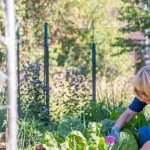Crop rotation is a fundamental practice in vegetable gardening that involves systematically moving plants to different areas of the garden each year. This simple yet powerful technique offers numerous benefits for the overall health and productivity of vegetable gardens.
By rotating plants, gardeners can enhance soil fertility, reduce the risk of disease and pest issues, prevent nutrient depletion, and maximize crop yield. In this article, we will explore the significance of rotating plants in vegetable gardens and provide a comprehensive guide on planning and implementing an effective crop rotation system.
Vegetable gardens thrive when they are balanced and nourished. Planting the same crops in the same area year after year can lead to imbalances in soil nutrients and create optimal conditions for pests and diseases to flourish. Crop rotation helps break these cycles by providing a diverse array of plants that have different needs and characteristics. As we rotate plants, we harness nature’s ability to replenish and rejuvenate the soil while keeping pests at bay.
In this article, we will delve into the numerous benefits of rotating plants in vegetable gardens. We will explore how this practice enhances soil fertility by moving plants to different locations, reduces the risk of disease and pest issues by breaking their life cycles, prevents nutrient depletion, maximizes overall yield, and improves crop quality.
Additionally, we will provide practical guidance on how to plan for crop rotation in a vegetable garden, including assessing available space, understanding plant families’ rotation requirements, creating a garden rotation plan using charts or calendars, considering environmental conditions when choosing suitable plant varieties, and employing companion planting techniques.
By embracing the concept of rotating plants in vegetable gardens through proper planning and implementation steps outlined in this article, you are equipping yourself with valuable knowledge for achieving a thriving and sustainable garden. So let’s dive into the benefits of rotating plants in vegetable gardens and discover how this practice can transform your gardening experience.
Benefits of Rotating Plants in Vegetable Gardens
Rotating plants in vegetable gardens offers a multitude of benefits that contribute to the overall health and productivity of the garden. By understanding and implementing crop rotation, gardeners can enhance soil fertility, reduce the risk of disease and pests, prevent nutrient depletion, and maximize their overall yield.
One of the key advantages of rotating plants is the enhancement of soil fertility and nutrient availability. When plants are moved to different locations each year, it helps break up any imbalances or deficiencies in the soil. Different plant varieties have varying nutrient requirements and deplete the soil of specific nutrients. By rotating crops, gardeners can ensure that the soil remains fertile and rich in essential nutrients.
In addition to nutrient benefits, crop rotation also plays a significant role in reducing the risk of disease and pest issues in vegetable gardens. Many common garden pests have life cycles that are closely tied to specific plant species.
By rotating crops each year, gardeners disrupt these life cycles, making it more difficult for pests to establish themselves in the garden. Similarly, certain diseases are often host-specific; therefore, moving plants within different families minimizes the risk of diseases spreading from one year to the next.
Furthermore, proper rotation helps prevent nutrient depletion in the soil. Plants from different families have distinct nutrient requirements and take up nutrients at varying rates. If plants from the same family are grown repeatedly in one spot without rotation, they can deplete specific nutrients from the soil over time. Rotating crops allows for a balanced uptake of different nutrients and prevents depletion.
By implementing crop rotation practices in vegetable gardens, gardeners can maximize their overall yield and improve the quality of their crops. Different plant families offer unique benefits to one another when rotated properly. For example, legumes such as peas and beans fix nitrogen in soil while leafy greens like lettuce add organic matter when they decompose. These interactions contribute to healthier plants that produce higher yields with better flavor and texture.
In summary, the benefits of rotating plants in vegetable gardens are numerous and vital for a successful garden. By enhancing soil fertility, reducing the risk of disease and pests, preventing nutrient depletion, and maximizing overall yield, gardeners can experience greater productivity and healthier crops. Implementing proper crop rotation techniques is an essential practice for any vegetable gardener committed to maintaining the long-term health and sustainability of their garden.
How to Plan for Crop Rotation in a Vegetable Garden
Planning for crop rotation in a vegetable garden is an essential step to ensure the success and productivity of your plants. By strategically moving plants to different locations within your garden, you can enhance soil fertility, reduce the risk of disease and pests, prevent nutrient depletion, and maximize overall yield. Here are some key steps to help you plan for crop rotation:
- Assess your available garden space: Begin by evaluating the size and layout of your vegetable garden. Divide it into designated planting areas or beds based on its dimensions. This will help you visualize the rotation plan more effectively.
- Understand plant families and their rotation requirements: Different plant families have varying needs when it comes to crop rotation. Research and familiarize yourself with the different plant families in your garden and their specific requirements. For example, nightshade family crops like tomatoes and peppers should not be planted in the same area year after year as they are prone to similar diseases.
- Create a simple garden rotation plan: Use a crop rotation chart or calendar to create a clear and organized plan for rotating your crops. The chart will help you keep track of which areas have had specific plants in previous years and where they should be moved next. Ensure that you rotate plants at least every two to three years.
- Consider environmental conditions: Take into account the unique environmental conditions of your garden such as sunlight exposure, watering needs, and soil type when planning your rotations. Choose suitable plant varieties that thrive under these conditions to increase their chances of success.
- Implement companion planting techniques: Companion planting is another effective technique that can enhance the benefits of crop rotation. It involves growing compatible plants together to deter pests, improve nutrient uptake, or provide shade or support for each other. Incorporating companion planting into your crop rotation plan can further optimize its effectiveness.
By following these steps, you can create a well-planned crop rotation system that promotes healthy soil, reduces pest and disease pressure, and increases the overall productivity of your vegetable garden. Taking the time to plan ahead will pay off in the long run, leading to stronger, more bountiful crops for years to come.
Crop Families and Their Rotation Requirements
When it comes to implementing a successful crop rotation plan in your vegetable garden, understanding the specific rotation requirements of different plant families is crucial. Rotating plants within the same family helps to prevent the buildup of pests, diseases, and nutrient deficiencies that can harm your crops over time.
By diversifying the types of plants grown in each designated area of your garden, you can maintain soil health and maximize overall productivity. Here are some common vegetable plant families and their rotation considerations.
Solanaceae Family
The Solanaceae family includes popular crops like tomatoes, peppers, eggplants, and potatoes. These plants are susceptible to many of the same diseases and pests, such as tomato blight or potato beetles. To prevent the buildup of these problems in your soil, it is important to rotate them every year or every two years at most. Try to avoid planting them in the same location for consecutive growing seasons.
Brassica Family
The Brassica family consists of crops like cabbage, broccoli, cauliflower, Brussels sprouts, kale, and radishes. These plants are prone to diseases like clubroot and cabbage worms. To avoid these issues, it is recommended to rotate them every three years. Consider rotating them with members of the legume family or other non-related crops to break pest and disease cycles effectively.
Cucurbit Family
The Cucurbit family includes cucumbers, melons, squash, pumpkins, and zucchini. These plants are vulnerable to pests like vine borers or cucumber beetles. It is best to rotate them every three years as well. Alternating between different areas for planting cucurbits helps reduce disease pressure from soil-borne pathogens.
Legume Family
The Legume family contains peas and beans such as snap peas, green beans, and lentils. Legumes have the unique ability to fix nitrogen into the soil, which makes them beneficial for garden health. However, they can suffer from diseases like bacterial wilt or various fungi. To maintain their productivity while minimizing these issues, it is recommended to rotate them every four years.
By understanding the rotation needs of different plant families in your vegetable garden, you can design a more effective and sustainable crop rotation plan. Remember to keep detailed records of your planting layout and rotation schedule for reference in future seasons. Implementing proper crop rotation not only promotes healthy soil but also leads to higher yields and better quality crops in the long run.
Practicing Crop Rotation
Implementing effective crop rotation techniques in a vegetable garden involves careful planning and strategic management. By following a step-by-step guide, gardeners can ensure the success of their rotation system and reap the rewards of a healthy and productive garden.
The first step in practicing crop rotation is to prepare the soil. Before planting, it is important to remove any residual roots or plant debris from the previous crops. This helps prevent the buildup of pests and diseases that may affect the new plants. Additionally, loosening the soil and incorporating organic matter such as compost can improve its fertility and structure.
Next, it is crucial to start with the correct planting layout and designate specific areas for rotation. These areas should be clearly labeled to avoid confusion later on. Dividing the garden into different planting beds or sections allows for better organization and makes it easier to keep track of which plants are being rotated each season.
When planning what crops to grow in each designated area, refer to the rotation schedule based on the specific plant families involved. Take into consideration how often each family should be rotated and which plants are closely related or prone to similar diseases or nutrient deficiencies. By rotating crops within these families accordingly, you can effectively break pest and disease cycles while preventing nutrient depletion in the soil.
Once you have determined which crops to plant where, follow best practices for transplanting or direct seeding according to the specific plant species. Pay attention to proper spacing requirements, watering needs, and overall care instructions for each crop. It is also helpful to keep a record or journal of what was planted in each area each year, as this will aid in future planning and troubleshooting.
By following this step-by-step guide for practicing crop rotation, you can maximize your vegetable garden’s health and productivity while minimizing pest and disease issues. Remember that implementing crop rotation is an ongoing process that requires observation, adaptation, and continuous improvement over time. By staying committed to this sustainable practice, you can enjoy a thriving and abundant garden year after year.
Potential Challenges and Troubleshooting
Implementing a crop rotation system in a vegetable garden can be highly beneficial, but it may come with its own set of challenges. From limited garden space to nutrient deficiencies and resistance to certain rotation strategies, gardeners may encounter obstacles that require troubleshooting. However, with proper planning and some innovative solutions, these challenges can be overcome to maintain a successful crop rotation system.
Limited Garden Space
One common challenge faced by many gardeners is limited space. It can be difficult to allocate designated areas for crop rotation when there is not enough room in the garden. In such cases, vertical gardening techniques such as trellises or container gardening can be utilized to make the most of available space.
Trellises allow plants like beans or cucumbers to grow vertically, saving ground space for other rotating crops. Additionally, containers provide an opportunity to rotate plants within each pot or move them around as needed.
Soil Nutrient Deficiencies
Another challenge that may arise when practicing crop rotation is soil nutrient deficiencies. While rotating crops helps prevent nutrient depletion in the soil, it does not guarantee a perfectly balanced nutrient profile in all areas of the garden.
To address this issue, regular soil testing should be conducted to identify any specific nutrient deficiencies. Based on the results, appropriate amendments such as compost, organic fertilizers, or cover cropping can be used to replenish the soil and ensure optimal plant growth and health.
Resistance to Rotation Strategies
Sometimes certain crops may not respond well to traditional rotation strategies due to their unique growth requirements or susceptibility to pests and diseases. In such cases, alternative approaches can be considered. Instead of completely eliminating plants from a specific family from the rotation plan, they can be rotated with other unrelated crops that are less susceptible to similar pests or diseases. Additionally, using resistant varieties of certain crops can help mitigate the risks associated with rotation challenges.
Overall, it is important for gardeners to remain flexible and adaptable when facing potential challenges with crop rotation. Experimentation, observation, and continuous improvement can help overcome these obstacles and optimize the effectiveness of the rotation system. By troubleshooting and finding innovative solutions, gardeners can maintain a healthy vegetable garden that yields bountiful harvests season after season.
Tips for Maintaining a Successful Crop Rotation System
Maintaining a successful crop rotation system is essential for ensuring the long-term health and productivity of a vegetable garden. Once a rotation plan has been established, it is important to regularly monitor and care for the garden to maximize its effectiveness. Here are some tips for maintaining a successful crop rotation system:
- Regular Soil Testing: Regularly testing the soil in your vegetable garden is crucial for maintaining optimal fertility levels. Soil tests can provide valuable information about nutrient deficiencies or imbalances, pH levels, and organic matter content. Based on the results of the soil test, you can make informed decisions about fertilizing and amending the soil to ensure it meets the specific needs of each crop.
- Proper Crop Residue Management: Effective management of crop residues can help prevent the buildup of pests and diseases in the garden. Remove any plant debris after harvesting and dispose of it properly to minimize the risk of overwintering pests or diseases. Additionally, consider incorporating cover crops into your rotation plan as they can help improve soil structure, suppress weeds, and provide additional organic matter when tilled under.
- Observation and Learning: As you practice crop rotation in your vegetable garden over time, take note of how different crops perform in each designated area. Pay attention to any patterns or variations in growth, yield, or pest/disease incidence. This observation will allow you to fine-tune your rotation schedule and adapt it based on your specific growing conditions.
| Tips for Maintaining a Successful Crop Rotation System |
|---|
| Regular Soil Testing |
| Proper Crop Residue Management |
| Observation and Learning |
Conclusion
In conclusion, rotating plants in vegetable gardens is a powerful practice that can greatly benefit the overall health and productivity of the garden. By moving plants to different locations, crop rotation enhances soil fertility and nutrient availability, reduces the risk of disease and pest issues, and prevents the depletion of specific nutrients. These benefits ultimately maximize overall yield and improve the quality of crops.
Planning for crop rotation in a vegetable garden involves assessing the available space, understanding different plant families and their rotation requirements, creating a rotation plan, considering environmental conditions, and implementing companion planting techniques. With proper planning and execution, gardeners can effectively rotate their crops to ensure optimum growth and minimize potential problems.
While there may be challenges in implementing crop rotation such as limited garden space or resistance to certain strategies, there are practical solutions available. Additionally, maintaining a successful crop rotation system involves regular soil testing and amending as needed, proper management of crop residue, and continuously improving the rotation plan based on personal experience and observation.
In embracing the power of rotating plants in vegetable gardens, gardeners can create sustainable systems that promote overall garden health and increased productivity. So why wait? Start incorporating this beneficial practice into your gardening routine today for thriving plants and bountiful harvests.
Frequently Asked Questions
Should you rotate plants in vegetable garden?
Rotating plants in a vegetable garden is generally recommended as it can help to maintain soil health and reduce the risk of plant diseases and pest infestations. By moving crops around from one area to another, different plant families are grown in different areas of the garden each year.
This practice can disrupt the life cycle of pests and diseases that may have built up in the soil over time, as well as prevent nutrient imbalances that can occur when the same crops are grown in the same location year after year.
How often should you rotate a vegetable garden?
The frequency of rotating a vegetable garden depends on various factors such as the size of the garden, specific plant families being grown, and any previous issues with pests or diseases. As a general guideline, rotating every year or every few years is often recommended to reap the benefits of this practice.
However, smaller gardens may rotate their crops more frequently due to space limitations. It’s important to observe your garden closely and adapt the rotation schedule based on its needs.
What is the best order for crop rotation?
Determining the best order for crop rotation can be influenced by several factors such as plant families, nutrient demands, and pest patterns. In a typical four-year crop rotation cycle, it is common to group plants into specific categories based on their botanical families. The sequence might start with legumes (beans, peas), followed by leafy greens (lettuce, spinach), then root vegetables (carrots, potatoes), and lastly fruiting vegetables (tomatoes, peppers).
This rotation pattern helps ensure that plants with similar nutritional needs don’t deplete specific nutrients from the soil consecutively and reduces the likelihood of pests targeting certain crops year after year. However, it’s important to note that optimal crop rotation will vary depending on individual circumstances such as local climate and pest prevalence. Consulting local extension services or experienced farmers/gardeners for recommendations specific to your region can provide valuable insights for implementing an effective crop rotation plan.

If you’re looking to get into vegetable gardening, or are just looking for some tips on how to make your current garden better, then you’ve come to the right place! My name is Ethel and I have been gardening for years. In this blog, I’m going to share with you some of my best tips on how to create a successful vegetable garden.





